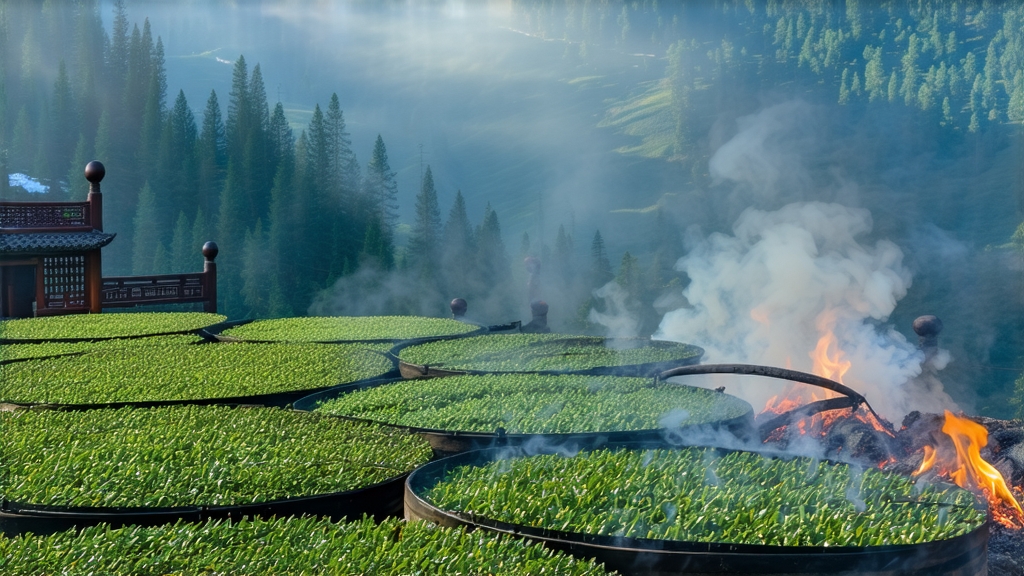
When European tea clippers first rounded the Cape of Good Hope in the late seventeenth century, the dark, tightly-twisted leaves they carried from the port of Xiamen were not yet called “black tea.” Merchants simply labeled the cargo “bohea,” a corruption of the Wuyi Mountains’ name, and dockside auctioneers in London praised its mysterious “smoky perfume.” That perfume belonged to Lapsang Souchong—today celebrated as the earliest intentionally crafted black tea in the world and the prototype for every malty Assam, bright Ceylon, or honeyed Keemun that followed.
Geographic Birthplace
Lapsang Souchong is born in Tongmu Guan, a protected enclave inside Fujian’s Wuyi UNESCO World Heritage site. Here, the Min River narrows into mist-filled gorges of weathered tuff and granite. At 600–1,200 m elevation, the subtropical monsoon climate traps morning fog beneath towering pine and cedar, creating a natural shading that slows leaf growth and concentrates amino acids. The indigenous cultivar is Xiao Ye Zhong (“small-leaf species”), a semi-wild Camellia sinensis var. sinensis shrub whose leaves are noticeably smaller and more resinous than those of the Assica variety used in most modern black teas. Local law restricts tea production to 110 sq km; any leaf picked beyond these boundaries may not bear the name “Zheng Shan” (“original mountain”), a legal designation akin to French appellation contrôlée.
Historical Trajectory
The precise date of Lapsang Souchong’s invention is debated, but Song dynasty (960–1279) gazetteers already mention “roasted and red” tea from Wuyi. The pivotal moment came during the Ming Jiajing era (1522–1566), when soldiers bivouacked in Tongmu drying sheds. To accelerate leaf processing before nightfall, farmers spread fresh plucks over pine fires. The resulting tea, suffused with resinous smoke, delighted passing Dutch traders who introduced it to Europe as “the Bohea leaf.” By 1604 the Dutch East India Company listed “Lapsang” (from the Fuzhou dialect la-sang, “pine wood”) at 8.2 guilders per pound—triple the price of green tea. In 1662 Catherine of Braganza’s dowry chest included two pounds of “Lapsang Souchong,” cementing its status as the fashionable beverage of the English court. When Scottish botanist Robert Fortune smuggled tea plants to India in 1848, he carried Tongmu seeds and withering techniques—genetic and technological heirs of Lapsang Souchong.
Leaf Grades & Styles
Within the Lapsang family three distinct styles exist, differentiated by smoking method and leaf grade:
-
Traditional Pine-Smoked Zheng Shan Xiao Zhong
Crafted only in Tongmu, using centuries-old pine wood from Massoniana and Pinus taiwanensis. The finished leaf is glossy black with golden tips; liquor glows amber-orange; aroma layers pine resin, longan fruit, and cooling camphor. -
Wuyi Non-Smoked Xiao Zhong
Introduced in 2005 for markets averse to heavy smoke. Leaves are withered over warm air ducts instead of pine fires, yielding a sweeter, raisin-like cup that purists argue is technically an unsmoked black tea, yet still sold under the Lapsang label. -
Modern Fruity “New Craft” Lapsang
A lightly smoked or even unsmoked version that undergoes 20% oxygen-limited fermentation, producing pronounced honey and lychee notes. Popular in specialty cafés for cold-brew infusions.
Crafting the Smoke: A Step-by-Step Journey
Plucking: Only the standard “two leaves and a bud” is picked between Qingming and Grain Rain (early April). Afternoon plucks are preferred because lower nighttime temperatures slow enzymatic oxidation, allowing more controllable withering.
Withering: Baskets of fresh leaf are laid on latticed bamboo racks suspended above squat, brick-lined fire pits. Pine logs, stripped of bark to reduce tar, smolder at 40–45 °C for 8–10 hours. Artisans shuffle the racks every 20 minutes so each leaf receives alternating currents of cool mountain air and warm smoke. Moisture drops from 75% to 58%, while guaiacol and syringol—volatile phenols responsible for the signature aroma—